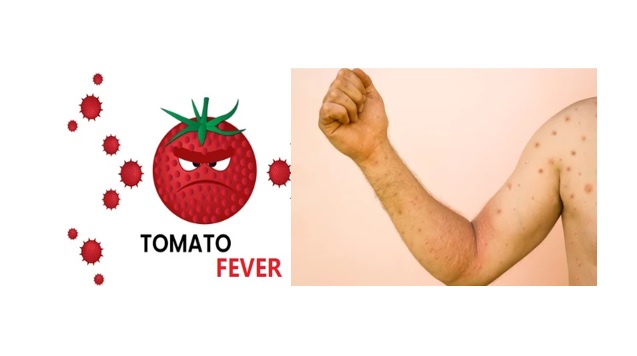Introduction
Moving on from Covid-19 and Monkeypox, there is now a new illness known as Tomato Fever, which is raising concerns across the country.
The infection has nothing to do with the tomatoes at all. It is a rare viral disease that causes red-colored rashes on the body and hence the name. It also causes skin irritation and dehydration.
Tomato Fever is also known as hand, foot, and mouth disease. While the illness is not fatal, it is very contagious. The causes of tomato fever are still unknown and scientists have still not figured out which specific family of viruses is causing this.
What is Tomato Fever/Flu?
In India, Tomato flu is an unidentified fever that has mostly been found in Kerala (a state of India) among children below 5 years of age.
While the disease is found only in some parts of Kerala (a South Indian state), health officials have warned that the virus could spread further if preventive measures are not taken in a proper way.
Cases of Tomato flu were initially reported from Kerala with about 80 cases. Cases have also been reported from the border district of Karnataka and Tamil Nadu. In Orissa, more than 2 dozen children have also been diagnosed with Tomato Fever. No deaths have been reported due to the virus yet.
What is “Tomato” in Tomato fever or Tomato flu?
Tomato flu got its name from the tomato-shaped blisters it causes on the body.
What are the symptoms of Tomato fever or Tomato Flu?
The flu mainly affects children below 5 years of age. The main symptoms of the disease include:
1. Rashes, Blisters, which are red in color, Skin irritation
2. Dehydration
3. Tiredness
4. Joint pain
5. Stomach cramps
6. Nausea and Vomiting
7. Diarrhea
8. Coughing
9. Sneezing and Runny nose
10. High fever
11. Body ache
What are the causes of Tomato Fever?
Doctors are still working to find out the group of viruses that causes Tomato Fever in children. Several virologists believe that “tomato fever” is likely a new variant of the viral hand, foot, and mouth infection (HFMD), which is very common in young children because of their weak immune systems.
Tamil Nadu’s Health Secretary, Dr. J Radhakrishnan, however, confirmed that the infection spreading in Kerala is caused by a virus variant of the HFMD disease and should NOT be confused with a new disease.
What is the diagnosis of Tomato Fever?
If your child is showing symptoms of flu with rashes and blisters, then you should take your child to the doctor for consultation.
The doctor will diagnose whether it is normal flu or tomato flu by asking about symptoms and duration.
The doctor will also identify the bloody blisters on the body and their positioning.
To make a diagnosis, the doctor will evaluate —
– the Age of the affected person,
– the Pattern of signs and symptoms, and
– the Appearance of the rash or sores.
This will help aid in distinguishing HFMD from other types of viral infections.
To determine the strain of the virus causing the illness, the doctor may take a throat swab or stool specimen and send it to the laboratory. Early detection of the infection is important in preventing an outbreak in the pediatric population.
Transmission of Tomato fever/flu
It is highly contagious and is transmitted by —
– nasopharyngeal secretions (saliva or nasal mucus),
– by direct contact, or
– by the fecal-oral route.
The bodily secretions can be infectious for several days, even after the symptoms have been resolved.
Like other cases of flu, tomato fever is also contagious. If someone is infected with this flu, they need to keep in isolation as this could spread rapidly from one person to another.
Treatment of Tomato fever/flu
The disease is self-limiting, and there is no specific drug for it. Good supportive care is required.
Excessive fluid intake helps in counteracting dehydration.
The infected child should be provided with a well-balanced diet, which would help in a speedy recovery.
To prevent the long-term effects of the disease, the infected child should get plenty of rest.
The child should be encouraged to not scratch their blisters as this may worsen the symptoms
What are the preventive measures?
- Like other cases of flu, tomato fever is also contagious. If someone is infected with the flu, they need to be kept isolated.
- It is essential to prevent children from scratching the blisters caused by the flu.
- Proper rest is also essential.
- Hygiene should also be maintained.
- Utensils, clothes, and other items used by the infected person or child must be sanitized to prevent the further spreading of the flu.
- Fluid intake should be increased, which will help to prevent dehydration.
- It has been observed that bathing with warm water gives a good result.
We have to remember that this flu is self-limiting, and there is no specific drug for this. This means the symptoms will resolve over time on their own if proper supportive measures are given. So don’t panic but be aware, take precautions, and follow the safety measures.
Thank you
MEDICAL ADVICE DISCLAIMER:
The Author does not provide any medical advice on this platform.
Viewing, accessing, or reading this blog does not establish any doctor-patient relationship.
The information provided in this blog does not replace the services and opinions of a qualified medical professional who examines you and then prescribes medicines.
And if you have any questions of medical nature, please refer to your doctor or the qualified medical personnel for evaluation and management at a clinic/hospital near you.
The content provided in this blog represents the Author’s own interpretation of research articles.
